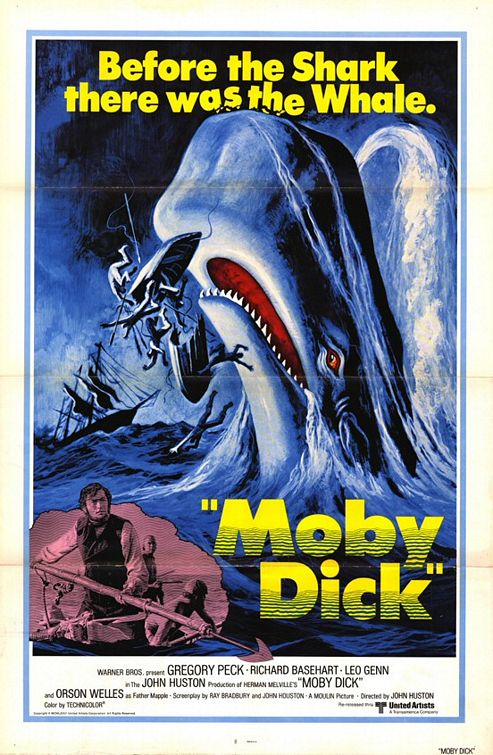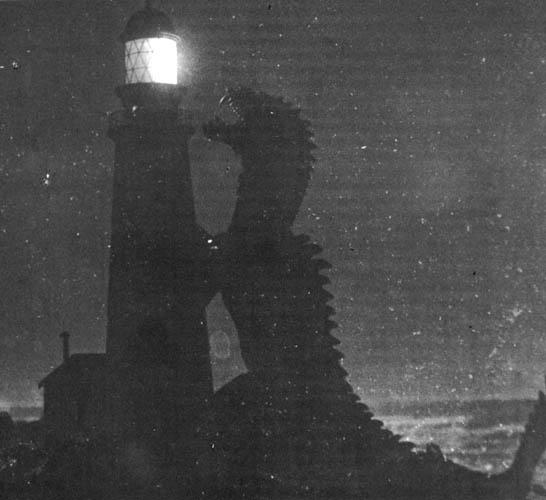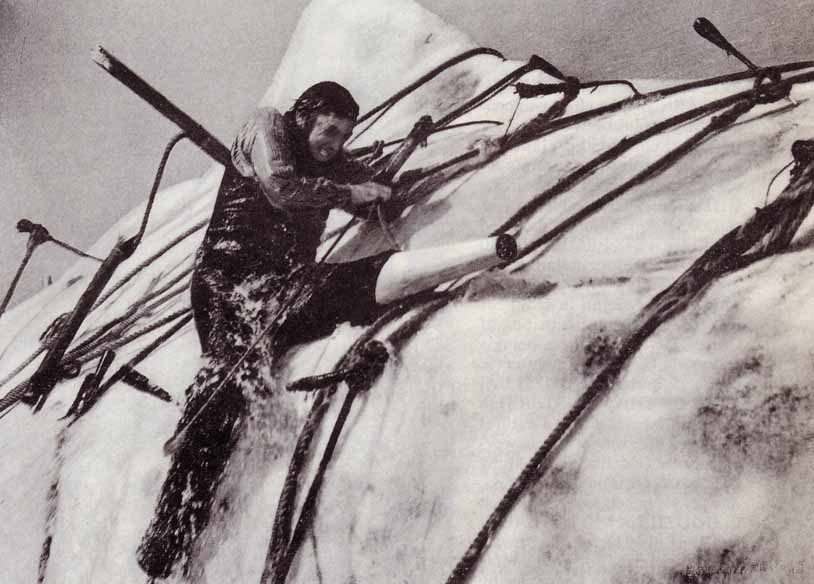 Moby Dick is not an obvious choice of material for adaptation to the screen. Nor is Ray Bradbury the obvious choice to have collaborated with famed director John Huston on a sea-going adventure that had little appeal to Hollywood studio chiefs. The science fiction author’s prose work, filled with different combinations of nostalgia, atmosphere and a sense of wonder, has often defied adaptation to the screen; and more often than not, his subject has been the future rather than the past—unless that past involved dinosaurs. Nevertheless, Bradbury somehow found common ground with Herman Melville’s tale. For all the novel’s allegorical ambitions, the white whale Moby Dick evokes a terrifying sense of awe; he is a beast bigger than any dinosaur, a behemoth as powerful as any sea monster. And much more than that, he is an enigma, a symbol of the mystery of the universe, a literal embodiment (if Captain Ahab is correct) of evil.
Moby Dick is not an obvious choice of material for adaptation to the screen. Nor is Ray Bradbury the obvious choice to have collaborated with famed director John Huston on a sea-going adventure that had little appeal to Hollywood studio chiefs. The science fiction author’s prose work, filled with different combinations of nostalgia, atmosphere and a sense of wonder, has often defied adaptation to the screen; and more often than not, his subject has been the future rather than the past—unless that past involved dinosaurs. Nevertheless, Bradbury somehow found common ground with Herman Melville’s tale. For all the novel’s allegorical ambitions, the white whale Moby Dick evokes a terrifying sense of awe; he is a beast bigger than any dinosaur, a behemoth as powerful as any sea monster. And much more than that, he is an enigma, a symbol of the mystery of the universe, a literal embodiment (if Captain Ahab is correct) of evil.
How did Bradbury come, in the middle of the 20th century, to be scripting a 19-century story about a mad captain’s hunt for a white whale of almost mythical proportions?
“Years ago,” Bradbury recalls, “people said, ‘When are you going to write a screenplay?’ I said, ‘When John Huston asks me.’ I knew exactly who I wanted to work for, because I’d seen his films, and I loved The Maltese Falcon; I saw it fifteen times. I finally had the chance to meet him: I had dinner with him one night in 1951, and I gave him all my books. I said, ‘If you like these books half as much as I like your films, someday hire me.’ He wrote me from Africa, where he was filming African Queen, and said, ‘We’ll work together. I don’t know on what, but we’ll work on something someday.’ In August of 1953,I was down in Long Beach looking for dinosaur books with my friend Ray Harryhausen, and when I came home that night, my wife said, ‘John Huston called; he wants to see you.’ The next day I went to John Huston’s hotel; he put a drink in my hand; he sat me down, stood over me, and said, ‘Well, kid, what are you doing during the next year?’ I said, ‘Not much, Mr. Huston.’ He said, ‘How would you like to come to Ireland and write the screenplay for Moby Dick?’ I said, ‘Well gee, I’ve never been able to read that damn thing!’ He said, ‘Why don’t you go home tonight, read as much as you can; then come back tomorrow and tell me if you’ll help me kill the White Whale.’ I went home and said to my wife, ‘Pray for me.’ She asked why, and I said, ‘Because I have to read a book tonight and do a book report tomorrow!’ I read through the book, as much as I could, and saw the metaphors and discovered that I am essentially a 19th Century author, loving metaphors. I went the next day and took the job.”
What had Huston seen in Bradbury’s work that convinced him to hire the young writer? The author credits a single short story for getting him the job.
 “I lived in Venice, California back in 1950,” Bradbury recalls, adding that he and his wife “walked along the shore one night and came upon the ruins of the old Venice peer, which had just been torn down; and the ruins of the roller-coaster were lying there in the sand, being covered by the wind and the water. I looked at the bones of the roller coaster and said to my wife, ‘I wonder what that dinosaur is doing lying here?’ My wife was very careful not to answer. The next night, I heard a sound and woke in the night. I looked out the window, and for ten miles down the coast there was nothing but wind and rain and sand. But a voice way out in the Santa Monica Bay called me; it was a foghorn, blowing over, and over, and over again. I said, ‘That’s it. The dinosaur is lying on the beach because it heard another dinosaur calling from a billion years, and it swam for an encounter with this other beast and discovered it was only a light house and a damn fog horn, and it tore the whole thing down and died of a broken heart. So I sat down and wrote ‘The Beast from 20,000 Fathoms,’ which became ‘The Foghorn,’ which I gave to John Huston in a book. He read my description of the melancholy sound of the foghorn, and based on that one story, he gave me the job of writing MOBY DICK.” (NOTE: Bradbury’s short story is now usually anthologized under the title “The Foghorn,” to distinguish it from the feature film THE BEAST FROM 20,000 FATHOMS, with special effects by Ray Harryhausen, which features a brief scene of the titular beast attacking a lighthouse—the only element the film and the story share in common.)
“I lived in Venice, California back in 1950,” Bradbury recalls, adding that he and his wife “walked along the shore one night and came upon the ruins of the old Venice peer, which had just been torn down; and the ruins of the roller-coaster were lying there in the sand, being covered by the wind and the water. I looked at the bones of the roller coaster and said to my wife, ‘I wonder what that dinosaur is doing lying here?’ My wife was very careful not to answer. The next night, I heard a sound and woke in the night. I looked out the window, and for ten miles down the coast there was nothing but wind and rain and sand. But a voice way out in the Santa Monica Bay called me; it was a foghorn, blowing over, and over, and over again. I said, ‘That’s it. The dinosaur is lying on the beach because it heard another dinosaur calling from a billion years, and it swam for an encounter with this other beast and discovered it was only a light house and a damn fog horn, and it tore the whole thing down and died of a broken heart. So I sat down and wrote ‘The Beast from 20,000 Fathoms,’ which became ‘The Foghorn,’ which I gave to John Huston in a book. He read my description of the melancholy sound of the foghorn, and based on that one story, he gave me the job of writing MOBY DICK.” (NOTE: Bradbury’s short story is now usually anthologized under the title “The Foghorn,” to distinguish it from the feature film THE BEAST FROM 20,000 FATHOMS, with special effects by Ray Harryhausen, which features a brief scene of the titular beast attacking a lighthouse—the only element the film and the story share in common.)
Bradbury moved his family to Ireland, where Huston lived at the time, and worked on the script for eight months. With 135 chapters, plus an Etymology, Epilogue and several pages of “Extracts,” Herman Melville’s novel was far from an ideal fit for a screenplay. Simply shoe-horning the narrative into a two-hour running time demanded the sacrifice of over three-quarters of the original text. Bradbury eliminated characters, combined elements of different chapters into single scenes, added new material, and changed many of the details. His first big decision was to eliminate Fedallah, Ahab’s Parsee confidant—a sort of Mephistophelean figure with no real characterization, whose function in the novel is almost totally symbolic.
“When we started, I said to John Huston two things: First, Can we throw Fedallah overboard? If you’ve read the book, you know Fedallah is a bore; he gets in the way. All the stuff that he does should be done by Ahab. John said, ‘Heave him overboard.’ So I threw him out. The second thing was, I said, ‘You must remember, during the screenplay and the film, to do the Shakespearean asides. This is the flesh of Melville; it’s very important. We’re doing a film of metaphor, so we have to have those moments of truth, which will speak to the audience, so they’ll know what’s going on from the soul’s midnight. I tried to find things in Melville to use constantly. We had to use the language as much as possible, to keep the Shakespearean flavor of Melville.”
Bradbury later wrote of his experiences in his episodic novel Green Shadows, White Whale (which is being republished this year). As Peter Viertel had previously done with White Hunter, Black Hear (written after working with Huston on The African Queen), Bradbury used his fictionalized version of reality to his relationship with director John Huston, who comes across as brilliant and talented, but sometimes cruel and abusive. Looking back on the experience today, Bradbury says that the relationship was not at all stormy or adversarial.
“We were both ignorant,” he says of grappling with the subject matter. “We were struggling against ourselves, not against each other, and when revelations came, it was wonderful. I must say, he was very patient with me. When I finished the first fifty-five pages, I gave them to John Huston and said, ‘Here’s the script so far. If you don’t like it, today is my last day of employment, because I don’t want to take money under false pretenses. If you don’t like it, fire me.’ He said, ‘Go upstairs and take a nap while I read it.’ So I went upstairs and took a nap—like hell I did! I lay in the bed sweating, waiting for some word from down stairs. At the end of an hour, I heard a voice calling up the stairs. I went and looked down at Huston, and he said, ‘Ray, come down and finished the screenplay.’ Well, I came down the stairs crying. I loved the project so much; it was such a relief to know that I was going to be able to finish.”
However, this was far from the last hurdle that the writer would have to leap. The film was something of a gamble for Huston, who had struggled for three years to get a Hollywood studio to back a film without a love interest or even a major female lead. “Eight weeks into writing the script, I was with Huston one afternoon when a telegram came from Warner Brothers in Hollywood,” Bradbury recalls. “It said, ‘Dear John, Insist that a woman’s part be written into the screenplay, or we cannot proceed with the productions. Jack Warner.’ I took this telegram, threw it on the ground; I jumped on it and called it all sorts of horrible names that I can’t repeat. In the middle of my jumping on the telegram, I looked up. Huston was rolling on the floor with laughter—he had sent the telegram himself!”
Jokes aside, there was plenty of hard work that went into the script. “It took seven months of reading and re-reading this book,” explains Bradbury. “You can’t intellectualize about adapting anything. You’ve got to really absorb it into your bloodstream. Then you begin to dream about it and think on a deeper level. After seven months of excruciating agony—there were times I wanted to kill myself, I didn’t know a damn thing about Melville when we started, and I discovered John Huston didn’t know anything, either—at the end of seven months, I got out of bed one morning and said, ‘I am Herman Melville.’ I ran to my typewriter and in eight hours of passionate typing, I finished the screenplay in one day—thirty-five pages, the whole ending of the film. I ran across Dublin with the screenplay and threw it in John Huston’s lap. I said, ‘There, I think it’s finished.’ He read it and said, ‘My god, I think it is; let’s roll the cameras. What happened?’ I said, ‘Behold, Herman Melville stands before you. But hurry up, because he’s leaving in five minutes.’ So that’s the way you write a screenplay of a book like this. I would like to think that if the ghost of Melville had seen this, he would find some of these [changes] okay. I don’t believe in running amok on people’s work; I try to find the essence.”
Inevitably, what emerged in 1956 was not a transcription but a condensation of Melville. And yet, despite the liberties taken with what many consider to be the closest thing to the proverbial “Great American Novel,” the film somehow manages to stand on its own feet (although, considering the subject matter, the metaphor should perhaps read “swim with its own flukes”). If there were any doubts that Huston and Bradbury made the right choices, these were put to rest by the 1998 television adaptation, starring Patrick Stewart as Captain Ahab. With a running time of 180 minutes, writers Anton Diether and Franc Roddam (who also directed) could retain more of Melville, and yet what emerged was curiously lifeless—like the well-preserved subject of an embalming, it captured the appearance but not the soul of its subject. Seen from this perspective, Huston’s MOBY DICK stands alongside Stanley Kubrick’s LOLITA as an example of a film that honors its source material with far greater artistic merit than the subsequent attempt at a “faithful” adaptation.

Just what is that mysterious essence of Moby Dick that Bradbury captured? What is the secret that lies behind “The Whiteness of the Whale” (as Melville titled one chapter)? “How many interpretations do you want?” Bradbury jokes. “We’re endowed with the gift of life. It’s a total mystery, and we try to make sense of it. We wake at night and say to ourselves, ‘This is incredible. We’re living on this world, and we don’t know how we got here.’ Scientists haven’t figured it out; they have theories, but they don’t know. The very existence of life is impossible. All the great religions have this mystery at their center, and Moby Dick is that mystery, and Ahab chooses to interpret that mystery in his way, and it’s not necessarily true. The mystery is not evil; it just is. And we are a mystery to ourselves. I feel this every day of my life. Moby Dick helped open this up to me.”
RELATED ARTICLES: Sons of Moby Dick – How the White Whale Spawned a School of Sea Monsters



